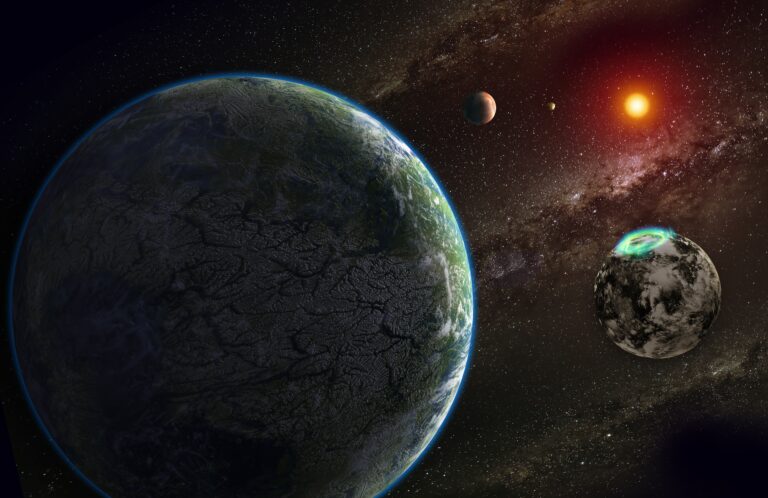
Key Takeaways:
Stars and their planets are typically named with numbers and letters from the surveys that discovered them. But those titles can seem nonintuitive and confusing to the public. Now, a set of 20 exoplanetary systems have been awarded proper names, thanks to teams of students, teachers, and amateur and professional astronomers from around the world.
The International Astronomical Union (IAU), whose rulings on astronomical definitions and names ensure a common language for science, is also dedicated to the promotion of astronomy and astronomical education around the world. In celebration of its Office for Astronomy Outreach’s 10th anniversary and to further encourage global participation in astronomy, the IAU recently hosted its third worldwide contest for naming exoplanetary systems. Called NameExoWorlds 2022, the contest invited teams to submit themed names for a set of extrasolar systems.
Although the winning names won’t replace the systems’ current scientific designations, they are sanctioned by the IAU and can be used in addition to or instead of the letter-and-number combinations used now.
Worldwide participation
The immense public participation in the contest proves just how intriguing and exciting exoplanets are. More than 8,800 individuals working in teams from 91 countries engaged over 11.9 million people through outreach events held as part of the contest requirements.
Events ranged from small gatherings to online lectures aimed at a larger audience. A team at Chittagong International School in Bangladesh created a week-long, all-inclusive festival with exhibitions, film screenings, and Q&A sessions. And the North Dakota Space Grant Consortium facilitated a handful of outreach events over the course of two months to promote the campaign. IAU President Debra Elmegreen said in a press release: “This large engagement of school children, the public, and professional astronomers in the competition is a fitting tribute to the efforts of the IAU Office of Astronomy Outreach over the past decade.”
Countries around the globe were given an opportunity to submit themed names for one of the 20 exoplanetary systems, which were chose because they are being specifically targeted for observation with the James Webb Space Telescope. Each pair of names had to follow a theme to ensure any future worlds that might be discovered can be given fitting names in keeping with the existing ones.

New names
Ultimately, the IAU received 603 entries suggesting names for host stars and their planets. Members of the Executive Committee WG Exoplanetary System Nomenclature, consisting of an IAU Working Group tasked with providing advice on guidelines and supporting the campaign, teamed up and consulted with the discovers of the exoplanets as part of the decision process to select these 20 names.
To emphasize the importance of linking the sky with our diverse cultures here on Earth, the IAU encouraged speakers of Indigenous languages to propose names. One selection that reflects this is the U.S.-submitted Noquisi and Awohali(for the star GJ 436 and its planet, GJ 436 b). These are the Cherokee words for “star” and “eagle,” and refer to the legend of an eagle who flew to the Sun to deliver a prayer for a warrior. Awohali was specifically chosen for the well-studied Neptune-like planet, which orbits very close to its host star.
Other exoplanetary systems were named based on their appearance. For instance, Phailinsiam (GJ 3470 b) is the Thai term for the blue Siamese sapphire. Detections of Rayleigh scattering — which is why Earth’s sky is blue — in the planet’s atmosphere indicate it, too, might have blue skies. In keeping with the theme, its host star, GJ 3470, is named Kaewkosin — the Thai name for the crystals of the Hindu deity Indra. This reflects the ancient belief that the stars in the sky were really sparkling gemstones. A Kenyan submission awarded the name Orkaria to the red dwarf star GJ 1214. This word is a term in the Maa language for red ochre, a color commonly worn by young warriors during cultural ceremonies.
Other newly adopted names were influenced by earthy elements, such as Gar and Su (GJ 486 and GJ 486 b), which refer to a Basque saying “su eta gar” (fire and flame), meaning passion and enthusiasm. Aiolos and Levantes (HD 95086 and HD 95086 b) are Greek names related to winds — the former from mythology and the latter from a 20th-century poem. And Wouri and Makombé (WASP-69 and WASP-69 b) are Duala names for a river and tributary in Cameroon that flow into the Gulf of Guinea.
The remaining exoworlds were named after native flora or fauna, ancient astronomical instruments, or to celebrate literary works and folklore. “The thoughtful names for these recently discovered planets and their stars, show that IAU public naming campaigns can draw upon the imagination of people around the world,” noted Eric Mamajek, chair of the NameExoWorlds 2022 campaign.
A full, detailed list of the names and their meanings can be found on the NameExoWorlds 2022 Approved Names webpage.









